TENDENCIES ID
Page 58
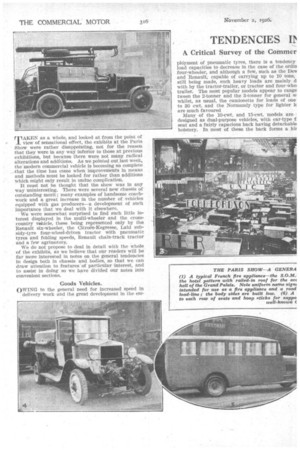
Page 59

Page 60
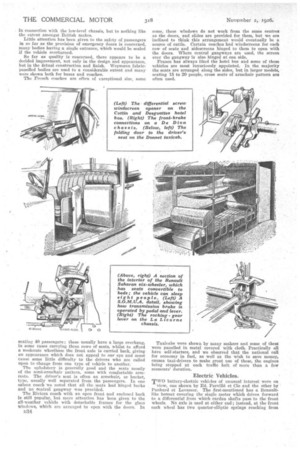
Page 61
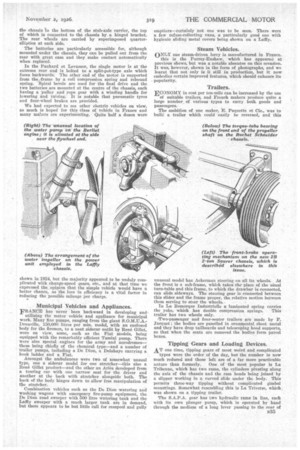
Page 62
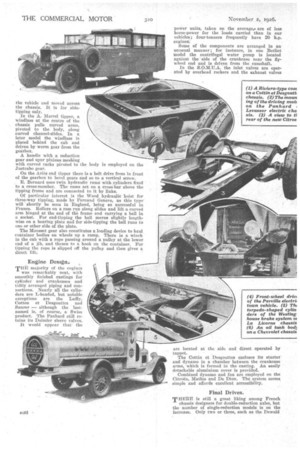
Page 63
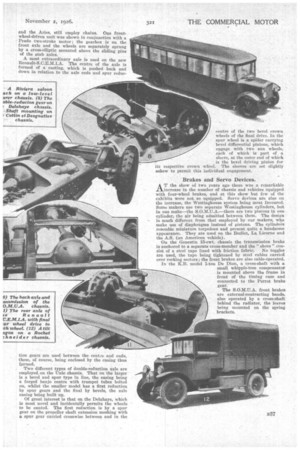
Page 64

Page 65
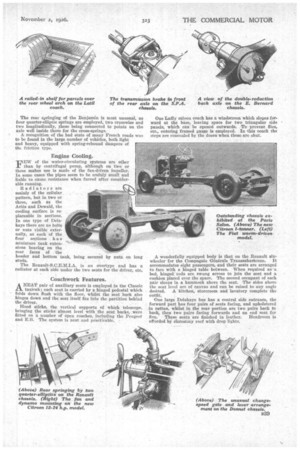
Page 66
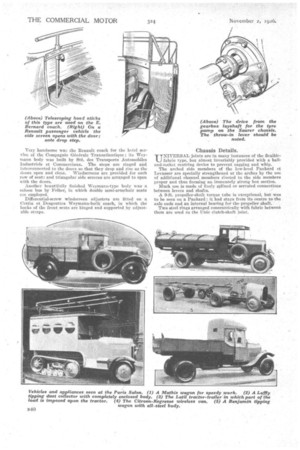
If you've noticed an error in this article please click here to report it so we can fix it.
tENCH DESIGN.
A Critical Survey of the Cornmer hide Exhibits at the Paris Show.
MAREN as a whole, and looked at from the point of view of sensational effect, the exhibits at the Paris Show were rather disappointing, not for the reason that they were in any way inferior to those at previous exhibitions, but because there were not many radical alterations and additions. As we pointed out last week, the modern commercial vehicle is becoming so complete „that the time has come when improvements in means and methods must be looked for rather than additions which might only result in undue complication.
It must not be thought that the show was in any way uninteresting. There were several new chassis of outstanding merit; many examples of handsome coachwork and a great increase in the number of -vehicles equipped with gas producers—a development of such importance that .we deal with it elsewhere.
We were somewhat surprised to find such little interest displayed in the multi-wheeler and the croascountry vehicle, these being represented only by the Renault six-wheeler, -the Citroen-Kegresse, Lahl subsidy-tyre four-wheel-driven tractor with pneumatic tyres and folding speeds, Renault chain-track tractor and a few agrimotom
We do not propose to deal in detail with the whole of the exhibits, as we believe that our readers will be far more interested in notes on the general tendencies in design both in chassis and bodies, so that we can draw attention to features of particular interest, and to assist in doing so we have divided our notes into convenient sections.
ployment of pneumatic tyres, there is a tendency load capacities to decrease in the case of the ordin four:wheeler, and although a few, such as the Devi and Renault, capable of carrying up to 10 tons, still being made, such heavy loads are mainly d with by the tractor-trailer, or tractor and four-who trailer. The most popular models appear to range tween the 2-tonner and the 3-tonner for general w whilst, as usual, the camionette for loads of one to 30 cwt, and the Normandy type for lighter h are much favoured
Many of the 10-cwt. and 15-cwt. models are designed as dual-purpose vehicles, with car-type f seat and a fairly capacious back having detachable holstery. In most of these the back forms a hit mard, but, when up, this does not mar the appearto any great extent, in fact, some of these useful vehicles are most practicable and we are surprised more is not done with them by farmers and others ur own country.
n interesting tendency is that towards developing des to meet particular requirements. For instance, me time the same model chassis might be called to carry a large body for light but bulky loads, t small body for heavy but compact goods, and it to be a mean to suit such different classes of work long-distance transport at high speeds or local very work in congested traffic. To avoid such iniistencies certain chassis, such as the Renault, have specially designed ; one, for instance, has an engine
rated at only 10 h.p., but a carrying capacity of 21 tons and a long frame for bodies to carry bulky goods. Even the tractor-trailer outfit is now built for much lighter work and, as an example of this, there is the new Lath, on pneumatic tyres, which is designed for 5-ton loads.
The Fordson tractor is receiving its share of attention, and several trailer outfits have been built for it. These are mostly of the four-wheeled pattern, embodying some means for imposing part of the load on to the rear wheels of the tractor, but, in general, the devices of this type are most complicated and do not compare with those built by our makers.
Some of the van bodies are excellently finished and decorated, but very little attention is given to the further development of mobile publicity. At some previous shows in Paris we have seen some really striking vehicles, with bodies modelled to represent, the goods they carry, but on this occasion we did not see a single example.
On one Panhard et Levassor there was a most unusual body, consisting of a platform flush with the wheel arches and a lower storey having slatted doors around the sides ; it was, presumably, intended for conveying poultry, etc., but could be used for many purposes. To assist in loading and unloading the platform two winch rollers were provided at the back.
In connection with the low-level chassis, but to nothing like the extent amongst British makes.
Little attention has been given to the safety of passengers in so far as the provision of emergency doors is concerned, many bodies having a single entrance, which would be sealed if the vehicle overturned.
So far as quality is concerned, there appears to be a decided improvment, not only in the design and appearance, but in the actual construction and finish. Weymann fabricpanelled bodies are used to a considerable extent and many were shown both for buses and coaches.
The French coaches are often of exceptional size, some seating 40 passengers; these usually have a large overhang, in some eases carrying three rows of seats, whilst to afford a moderate wheelbase the front axle is carried back, giving an appearance which does not appeal to our eye and must cause some little difficulty to the drivers who are called upon to change from one type of vehicle to another.
The upholstery is generally good and the seats mostly of the semi-armchair pattern, some with comfortable armrests. The driver's seat is often an armchair, or bucket, type, usually well separated from the passengers. In one saloon coach we noted that all the seats had hinged backs and no central gangway was provided.
The Riviera coach with an open front and enclosed back is still popular, but more attention has been given to the all-weather vehicle with detachable frames for the glass windows, which are arranged to open with the doors. In
n34 some, these windows do not work from the same centres as the doors, and slides are provided for them, but we are inclined to think this arrangement would eventually be a source of rattle. Certain coaches had windscreens for each row of seats and sidescreens hinged to them to open with the doors. Where central gangways are used, the screen over the gangway is also hinged at one side.
France has always liked the hotel bus and some of these vehicles are most luxurionsly appointed. In the majority the seats are arranged along the sides, but in larger models, seating 15 to 20 people, cross seats of armchair pattern are often used.
Taxicabs were shown by many makers and some of them were panelled in metal covered with cloth. Practically all have self-starters, and we observed that the national call for economy in fuel, as well as the wish to save money, causes taxi-drivers to make great use of these, the engines being stopped at each traffic halt of more than a few moments' duration.
Electric Vehicles.
TWO battery-electric vehicles of unusual interest were on view, one shown by Ed. Parvill4 et Cie and the other by Panhard et Levassor. The first-mentioned has a Renaultlike bonnet covering the single motor which drives forward to a differential from which cartlan shafts pass to the front wheels. No axle is used at either end ; instead, at the front each wheel has two quarter-elliptic springs reaching from
the chassis lo the bottom of the stub-axle carrier, the top of which is connected to the chassis by a hinged bracket. The rear wheels are carried by superimposed quarterellipties at each side.
The batteries are particularly accessible for, although mounted under the chassis, they can be pulled out from the rear with great ease and they make contact automatically when replaced.
In the Panhard at Levassor, the single motor is at the extreme rear and is bolted to a split-pot-type axle which faces backwards. The other end of the motor is supported from the,, frame by a coil compression spring and rebound spring. Spiral bevels are used for the final drive and the two batteries are mounted at the centre of the chassis, each having a pulley and rope gear with a winding handle for lowering and raising. It is notable that pneumatic tyres and four-wheel brakes are provided.
We had expected to see other electric vehicles on view, as much is hoped for this class of vehicle in France and many makers are experimenting. Quite half a dozen were
shown in 1924, but the majority appeared to be unduly complicated with change-speed gears, etc., and at that time we expressed the opinion that the simple vehicle would have a better chance, as the loss in efficiency is a vital factor in reducing the possible mileage per charge.
Municipal Vehicles and Appliances.
FRANCE has never been backward in developing and
utilizing the motor vehicle and appliance for municipal work. Many fine pumps, ranging from the giant S.O.M.U.A.Drouville, 150,000 litres per min. model, with an enclosed body for the firemen, to a neat sidecar outfit by Rene Gillet, were on view, some, such as the Fiat niodels, being equipped with the remarkably efficient Tamini pump. There were also special engines for the army and aerodromes— these being chiefly of the chemical type—and a number of trailer pumps, including a De Dion, a Delahaye carrying a hook ladder and a Fiat.
Amongst the ambulances were two of somewhat unseal type, one a sidecar model for one stretcher—this also a Rene Gillet product—and the other an Aries developed from a touring car with one narrow seat for the driver and another at the back with stretcher alongside both. The back of the body hinges down to allow free manipulation of the stretcher.
Combination vehicles such as the De Dion watering and washing wagons with emergency fire-pump equipment, the De Dion road sweeper with 500 litre watering tank and the Laffiy sweeper with a much larger tank are in demand, but there appears to be but little call for cesspool and gully
emptiers—certainly not One was to be seen. There were a few refuse-collecting vans, a particularly good one with hygienic sliding metal covers being shown on a Laffiy.
Steam Vehicles.
ONLY one steam-driven lorry is manufactured in France. this is the Purrey-Exshaw, which has appeared at previous shows, but was a notable absentee on this occasion. It was, however, shown in the form of photographs, and we learnt that not only is it still in production, but it now embodies certain improved features, which should enhance its popularity.
Trailers.
ECONOMY in cost per ton-mile can be increased by the use of suitable trailers, and French makers produce quite a large number, of various types to carry both goods and passengers. The ambition of one maker, E. Paquette et Cie., was to bale a trailer which could easily be reversed, and this
unusual model has Ackerman steering on all its wheels. At the front is a sub-frame, which takes the-place of the usual turn-table and this frame, to which the drawbar is connected, can slide sideways. The steering gear is connected between this slider and the frame proper, the relative motion between them serving to steer the wheels.
In La Remorque Industrielle a laminated spring carries the yoke, which has double compression springs. This trailer has two wheels only. •
,Two-passenger and four-seater trailers are made by F. Jacquet ; the bodies are panelled in ornamental sheet metal and they have drop tailboards and telescoping hood supports, so that when the seats are removed the bodies form parcel boxes.
Tipping Gears and Loading Devices.
AT one time, tipping gears of most weird and complicated types were the order of the day, but the number is now much reduced and those left are of a far more practicable nature than formerly. One of the most popular is La Tribenne, which has two rams, the cylinders pivoting along the axis of the chassis and the ram heads being joined by a slipper working in a curved slide under the body. This Permits three-way tipping without complicated gimbal mountings. Somewhat resembling this is La Triverse, which, was shown on a tipping trailer.
The S.A.P.A. gear has two hydraulic rams in line, each with its own plunger pump, which is operated by hand through the medium of a long lever passing to the rear of B35 the vehicle and mod across the chassis. It is for sidetipping only.
In the 'A. Marrel tipper, a windlass at the centre of the chassis pulls curved arms, pivoted to the body, along curved channel-slides. In a later model the windlass is placed behind the cab and driven by worm gear from the gearbox.
A handle with a reduction gear and spur pinions meshing with curved racks pivoted to the body is employed on the Justrabo gear.
On the Aries end tipper there is a belt drive from in front of the gearbox to bevel gears and so to a vertical screw.
E. Bernard uses twin hydraulic rams with cylinders fixed to a cross-member. The rams act an a cross-bar above the tipping frame and are connected to it by links.
Of particular interest is the Wood hydraulic hoist for three-way tipping, made by Fernand Geneve, as this type will shortly be seen in England, being so successful in France. Rollers on a ram run along slides and lift a curved arm hinged at the end of the frame and carrying a ball in a socket. For end-tipping the ball moves slightly lengthwise on a bearing plate and for side-tipping the ball runs to one or other side of the plate.
The Monsset gear also constitutes a loading device to haul container bodies on wheels up a ramp. There is a winch in the cab with a rope passing around a Pulley at the lower end of a jib, and thence to a hook on the container. For tipping the rope is slipped off the pulley and then gives a direct lift.
power units, taken on the average/1. are of less horse-power for the loads carried than in our vehicles; four-tonners frequently have 20 h.p. engines.
Some of the components are arranged in an unusual manner; for instance, in one Berliet model the centrifugal water pump is located against the side of the crankcase near the flywheel end and is driven from the camshaft.
In the S.011.1T.A. the inlet valves are operated by overhead rockers and the exhaust valves are located at the side and direct operated by tappet.
The Cottin et Desgouttes encloses its starter and dynamo in a chamber between the crankcase arms, -which is formed in the casting. An easily detachable aluminium cover is provided.
Combined dynamo and fan are employed on the Citrogn, Mathis and De Dion. The system seems, simple and affords excellent accessibility.
Final Drives.
T HERE is still a great liking among French chassis designers for double-reduction axles, but the number of single-reduction models is on the increase. Only two or three, such as the Dewald and the Aries, still employ chains. One frontwheel-driven unit was shown in conjunction with a Prado two-stroke motor; the gearbox is on the front axle and the wheels are separately sprung by a cross-elliptic mounted above the sliding pins of the stub axles.
A most extraordinary axle is used on the new Renault-S.C.E.M.I.A. The centre of the axle is formed of a casting, which is pushed back and down in relation to the axle ends and spur reduc tion gears are used between the centee and ends, these, of course, being enclosed by the casing thus tormed.
Two different types of double-reduction axle are employed, on the Unic chassis. That on the larger is a bevel and spur type in line, the casing being a forged banjo centre with trumpet tubes bolted on, whilst the smaller model has a first reduction by spur gears and the final by bevels, the axle easing being built up.
Of great interest is that on the Delabaye, which is most novel and incidentally permits the wheels to be canted. The first reduction is by a spur gear on the propeller shaft extension meshing with a spur gear carried crosswise between and in the
centre of the two bevel crown wheels of the final drive. In the spur wheel is a spider carrying bevel differential pinions, which engage with two sun wheels, each of which is part of a sleeve, at the outer end of which is the bevel driving pinion for its respective crown wheel. The sleeves are set slightly askew to permit this individual engagement.
Brakes and Servo Devices.
AT the show of two years ago there was a remarkable increase in the number of chassis and vehicles equipped with four-wheel brakes, and at this show but few of the exhibits were not, so equipped. Servo devices are also on the increase, the WeStinghouse system being most favoured. Some makers use two separate Westinghouse cylinders, but in one make—the S.O.M.U.A.—there are two pistons in one cylinder; the air being admitted between them. The design is much different from that employed by our makers, who make use of diaphragms instead of pistons. The cylinders resemble miniature torpedoes and present quite a handsome appearance. They are used on the Bernet, La Licorne and the A.S. (an American vehicle).
On the Genestin 15-cwt. chassis the transmission brake is anchored to a separate cross-member and the " shoes " con sist of a steel tape lined with friction fabric. No toggles are used, the tape being tightened by steel cables carried over rocking sectors; the front brakes are also cable-operated.
In the K.E. model 1-ton De Dion, a cross-shaft with a small whipple-tree compensator is mounted above the frame in front of the timing case and connected to the Perrot brake gear..
The S.O.M.U.A.. front brakes are external-contracting bands, also operated by a cross-shaft behind the radiator, the leaves being mounted on the spring brackets. A neat feature of the front brakes on the E.B. chassis is the closely coiled torsion spring which constitutes a section of each cam-operating shaft and serves to prevent excessive power from being applied.
The position of the transmission brake varies considerably.
For instance, in the it is immediately in front of the double-reduction axle.
Ball-jointed rods are used for both the front and rear brakes on the Panhard et Levassor vehicles.
A vacuum servo brake is used on the trailer for Fordsons built by ender Freres.
Brake adjustment on the Renault-S.O.E.M.I.A. selected by rotating a worm in the boss of each lever, this engaging with worm teeth cut in the spindles. Incidentally the famous Renault friction-disc servo, which works in both directions, is fitted.
Simple fork joints arc used in the llochet-Schneider front 3338
brake, but the connections are continued through the frame side members and tile levers mounted inside under the radiator.
Suspension Systems.
WHERE are few outstanding developments in chassis 1 suspension, although some of the systems are rather unusual, for example, in the latest Renault chassis qbarterelliptics bolted into the ends of an arched channel crossmember have been substituted for the. conventional type. The Renault-S.C.E.M.I.A. has long, fiat rear 'springs with only a few plates, these, however, being 6 ins. wide.
A. Vermin showed on one of the accessory stands a device consisting of two arms or levers, each with two coil springs mounted in a casing bolted to the axle, the levers taking the place of laminated half-elliptic springs. It appears to us-that too much energy would have to be stored by such small springs as it is only possible to employ.
Half-elliptic rear springs splayed out to a considerable extent at the back are a feature of the latest 1-ton Citron. In effect they give a wider spring base and limit rolling without causing other disadvantages.
• Front axles are now usually set well forward of the spring centres, partly to give better resistance against braking torque and partly to assist in the prevention of wheel "shimmy." The rear springing of the Benjamin is most unusual, as four quarter-elliptic springs are employed, two crosswise and two longitudinally, these being connected to points on the axle well inside those for the cross-springs.
A recognition of the bad state of many French roads was to be found in the large number of vehicles, both light and heavy, equipped with spring-rebound dampers of the friction type.
Engine Cooling.
FEW of the water-circulating systems are other than by centrifugal pump, although on two or three makes use is made of the fan-driven impeller. In some cases the pipes seem to be unduly small and liable to cause resistance when furred after considerable running.
Radiators are mainly of the cellular pattern, but in two or three, such as the Aries and Dewalci, the cooling surface is replaceable in sections. In one type of Delahaye there are no bolts or nuts visible externally, as each of the four sections h a a miniature tank extensions bearing on the rear faces of the header and bottom tank, being secured by nuts on long studs.
The Renault-S.C.E.M.I.A. is an overtype and has a radiator at each side under the two seats for the driver, etc.
Coachwork Features.
ANEAT pair of auxiliary seats is employed in the Classic taxicab; each seat is carried by a hinged pedestal which fold S down flush with the floor, whilst the seat back also hinges down and the seat itself fits into the partition behind the driver.
Hood sticks, the vertical supports of which telescope, bringing the sticks almost level with the seat backs, were fitted on a number of open coaches, including the Peugeot and RE. The system is neat and predicable.
One Laffly salami coach has a windscreen which slopes forward at the base, leaving space for two triangular side • panels, which can be opened outwards. To prevent flies, etc., entering framed gauze is employed. In this coach the steps are concealed by the doors when these are shut.
A wonderfully equipped body is that on the Renault sixwheeler for the Compagnie Gen6rale Transsaharienne. It accommodates eight passengers, and their seats are arranged to face with a hinged table between. When required as' a bed, hinged rods are swung across to join the seat and a cushion placed over the space. The second occupant of each pair sleeps in a hammock above the seat. The sides above the seat level are of canvas and can be raised to any angle desired. A kitchen, storeroom and lavatory complete the outfit.
One large Delahaye bus has a central side entrance, the forward part has four pairs of seats facing, and upholstered in rattan, whilst in the rear portion are two pairs back to back, then two pairs facing forwards and an end seat for five. These seats are finished in leather. Headroom is afforded by clerestory roof with drop lights.
Very handsome was the Renault coach for the hotel service of the Compagnie Generale Transatlantique; its Wcymann body was built by Std. des Transports Automobiles Inchistriels et Commereiaux. The steps • are ringed and interconnected to the doors so that they drop and rise as the doors open and close. -Windscreens are Provided for each row of seat and triangular side screens arc arranged to open with the doors.
Another beautifully finished Weymanu-type body was a saloon bus 14 Felber, in which double semi-armchair seats are employed.
Differential-screw windscreen adjusters are fitted on a Cottin at Desgouttes Weynaann-builf coach, in which the backs of the front seats are hinged and supported by adjustable straps.
TTNIVERSAL joints are in many instances of the flexible fabric type, but almost invariably provided with a balland-socket centring device to prevent sagging and whip. The arched side members of the low-level Panhard et Levassor are specially strengthened at the arches by the use of additional channel members riveted to the side members proper and thus forming an immensely strong box section. Much use is made of finely splined or serrated connections between levers and shafts.
A 9-ft. propeller-shaft torque tube is exceptional, but was to be seen on a Panhard; it had stays from its centre to the axle ends and an internal bearing for the propeller shaft.
Two steel rings arranged concentrically with fabric between them are used as the Unic clutch-shaft joint.




























































































































